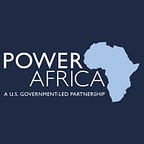Zambia’s First Public-Private Mini-Grid
In late March, Zambia gained its first independently owned power system, the Muhanya Solar Mini-Grid. The U.S. African Development Foundation (USADF), along with Officials from Zambia’s Ministry of Energy and Water Development and the Zambian Rural Electrification Authority officially joined the developers for the first day of operations of the mini-grid.
USADF, in partnership with Power Africa and the U.S.-based company General Electric, led the Off-Grid Energy Challenge to develop and scale-up proven technologies for off-grid energy to reach communities not served by existing power grids. Through the Off-Grid Energy Challenge, Zambia’s Muhanya Solar Limited was awarded a $100,000 grant in 2016 to develop a 30-kilowatt mini-grid in Sinda, an off-grid community in Eastern Zambia.
“Muhanya Solar exemplifies how Zambian ingenuity in partnership with American support can achieve results,” said Tom Coogan, USADF Regional Director. “Mini-grids like this one might be the future for many of the most remote towns and villages in the world — instead of waiting for the national grid to arrive, people are turning on the light switch today.”
Currently, Zambia has 2,400 megawatts (MW) of installed electrical capacity, virtually all of which is hydro, and only 47 percent of the urban population and 4 percent of the rural population have access to power. In Zambia, Power Africa endeavors to increase generation capacity by 900 MW, increase access to an additional 1 million households, and provide off-grid connections to 300 health posts.
Before the solar mini-grid, residents of the town of Sinda relied entirely upon kerosene lamps, candles and car batteries for power. Now, with the flick of a switch, residents can light their homes, charge their appliances like mobiles phones, and listen to radios. Residents pay an upfront connection fee and a set amount each week or month for the use of electricity. The residents also contributed their own labor and materials for the construction of the plant.
“With only 4 percent of rural households connected to power and the slow pace of expanding the national grid, the future of electricity in Zambia’s rural areas will largely depend on beyond the grid solutions, such as mini-grids and rooftop solar systems,” said USAID/Zambia’s Economic Office Director, Jeremy Boley.
“With only 4 percent of rural household connected to power and the slow pace of expanding the national grid, the future of electricity in Zambia’s rural areas will largely depend on beyond-the-grid solutions, such as mini-grids and rooftop solar systems,” said USAID/Zambia’s Economic Office Director, Jeremy Boley.
“This program, with Power Africa support, seeks to increase sustainable access to energy by spurring investment in innovative off-grid ventures.”
Founded in 2005, Muhanya worked with technology supplier African Energy, an American solar company based in Arizona which sources many products from American manufacturers. The mini-grid is providing new electricity connections to 60 households, a school and a grocery store. To meet the still large unmet demand in the town, Muhanya plans to scale up the mini-grid.
Through the Off-Grid Energy Challenge, USADF has funded over 70 off-grid energy companies in nine countries in Africa, and invested over $7 million in Africa’s energy entrepreneurs, which has already resulted in over 16,500 actual connections benefitting over 82,000 people.
